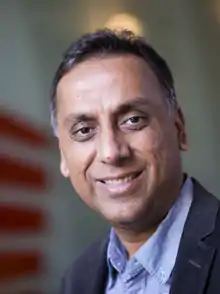Nilanjan Chatterjee
Nilanjan Chatterjee is a Bloomberg Distinguished Professor[1] of Biostatistics and Genetic Epidemiology at Johns Hopkins University, with appointments in the Department of Biostatistics in the Bloomberg School of Public Health and in the Department of Oncology in the Sidney Kimmel Comprehensive Cancer Center in the Johns Hopkins School of Medicine.[1][2] He was formerly the chief of the Biostatistics Branch of the National Cancer Institute's Division of Cancer Epidemiology and Genetics.
Nilanjan Chatterjee | |
|---|---|
 | |
| Born | c. 1972 (age 48–49) |
| Alma mater | University of Washington (Ph.D., 1999) Indian Statistical Institute (M.S., 1995) Ballygunge Government High School |
| Awards | Mortimer Spiegelman Award (2010) Snedecor Award (2011) COPSS Presidents' Award(2011) Bloomberg Distinguished Professorships (2015) |
| Scientific career | |
| Fields | Epidemiology Statistics Biostatistics Oncology |
| Institutions | Johns Hopkins University (current) National Institutes of Health (1999-2015) |
| Thesis | Semiparametric inference based on estimating equations in regressions models for two phase outcome dependent sampling |
| Academic advisors | Norman Breslow Jon August Wellner |
Biography
Chatterjee was born in Kolkata, India, to parents Aditya Nath and Pranati Chatterjee. He attended Ballygunge Government High School and Saint Xavier's College. He received his bachelor's degree in statistics from the Indian Statistical Institute in 1993, and his master's in 1995.[3] Chatterjee earned his PhD in Statistics from the University of Washington, Seattle in 1999.[4] His PhD thesis, titled "Semiparametric Inference Based on Estimating Equations in Regression Models for Two-Phase Outcome-Dependent Sampling," was advised by Norman Breslow and Jon A. Wellner.[5]
Chatterjee joined the National Cancer Institute (NCI) as a postdoctoral fellow in the biostatistics branch of the Division of Cancer Epidemiology and Genetics (DCEG) in 1999, and became a tenure-track investigator in 2001 and a senior investigator in 2004. He served as chief of the biostatistics branch from 2008 until 2015.[3] He remains a Special Volunteer at the NCI.[6]
Research
Chatterjee is known for his work in quantitative genetics, cancer research, big data, statistical methodology, genomics, gene-environment interaction, genetic association and genome-wide association studies.
Chatterjee developed a model for predicting breast cancer risk that combines individual-level data on risk factors such as smoking and age with genetic variations associated with higher risk of breast cancer.[7] He led a large collaboration of experts from the Johns Hopkins School of Medicine, the Bloomberg School of Public Health, and the Whiting School of Engineering that used big data and machine learning to develop tools for autism risk prediction and intervention.[8][9]
Chatterjee has participated in the Johns Hopkins Individualized Health Initiative (Hopkins inHealth), which aims to improve individual and population health outcomes through innovative collaborations among experts in biomedical and data science.[2][10] Chatterjee's contributions to the initiative involved research on using genetic markers for risk prediction models as well as their applications to personalized medicine and public health interventions.[2]
Through his quantitative studies of gene-environment and gene-gene interactions, Chatterjee has also made fundamental contributions to theoretical and methodological approaches in epidemiology and biostatistics.[2][3] Using statistics from genome-wide association studies to appraise the number of DNA variations that contribute to different physical traits and diseases, Chatterjee and colleagues developed a method for estimating the number of individual samples needed in order to identify genetic bases of traits, such as height or body mass index (BMI), or diseases, such as diabetes or bipolar disorder.[11] This method can be used for designing genetic studies and understanding genetic risk prediction.[12]
Awards
- Fellow of the American Statistical Association (2008)[13]
- Mortimer Spiegelman Award (2010)
- George W. Snedecor Award (2011)
- COPSS Presidents' Award (2011)
- Gertrude Cox Award (2011)[3]
- Elected Member of the American Epidemiologic Society (2012)[14]
References
- "Bloomberg Distinguished Professorships".
- Messersmith, Julie "Nilanjan Chatterjee named Bloomberg Distinguished Professor", JHU Hub, Baltimore, 11 November 2015. Retrieved on 11 November 2015.
- "Nilanjan Chatterjee Wins COPSS Awards". Amstat News. Retrieved 15 July 2020.
- "Nilanjan Chatterjee, Ph.D." National Cancer Institute.
- Nilanjan Chatterjee at the Mathematics Genealogy Project
- "Nilanjan Chatterjee, Ph.D. - Special Volunteer, biographical sketch and research interests - National Cancer Institute". dceg.cancer.gov. 1 January 1980. Retrieved 15 July 2020.
- May 26, Hub staff report / Published; 2016 (26 May 2016). "Healthy lifestyle choices can help women overcome genetic breast cancer risk". The Hub. Retrieved 15 July 2020.CS1 maint: numeric names: authors list (link)
- June 11, Hub staff report / Published; 2018 (11 June 2018). "30 interdisciplinary research teams receive Johns Hopkins Discovery Awards". The Hub. Retrieved 15 July 2020.CS1 maint: numeric names: authors list (link)
- "Johns Hopkins Discovery Awards: 2018 Awardees". Johns Hopkins Office of Research.
- "Signature Initiatives". Johns Hopkins Office of Research.
- Zhang, Yan; Qi, Guanghao; Park, Ju-Hyun; Chatterjee, Nilanjan (2018). "Estimation of complex effect-size distributions using summary-level statistics from genome-wide association studies across 32 complex traits". Nature Genetics. 50 (9): 1318–1326. doi:10.1038/s41588-018-0193-x. ISSN 1546-1718. PMID 30104760. S2CID 51979576.
- Aug 13, Robin Scullin / Published; 2018 (13 August 2018). "Understanding genetic architecture of different traits and diseases could lead to better-designed studies, researchers say". The Hub. Retrieved 15 July 2020.CS1 maint: numeric names: authors list (link)
- "Nilanjan Chatterjee was elected Fellow of the American Statistical Society. | University of Washington Department of Statistics". www.stat.washington.edu. Retrieved 15 July 2020.
- Health, JH Bloomberg School of Public. "Nilanjan Chatterjee - Faculty Directory". Johns Hopkins Bloomberg School of Public Health. Retrieved 15 July 2020.